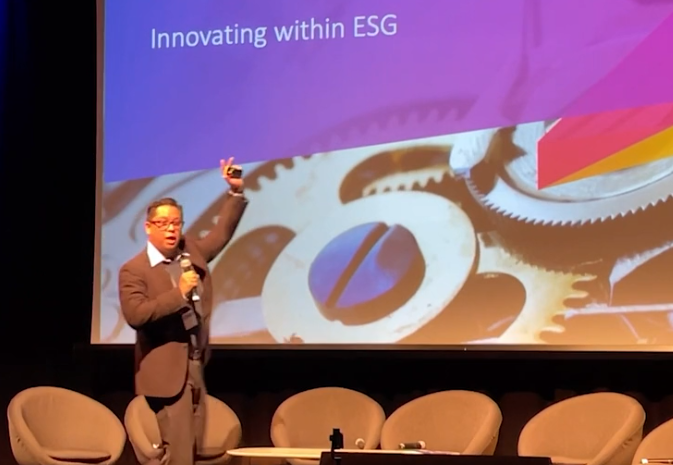M+E Connections

British HITS: Innovations Will Help Companies Achieve ESG Goals, CommScope Says
Story Highlights
Network evolution has always been a conversation about ever-increasing speeds and feeds to help process and access data. But new architectures also offer an opportunity to reduce materials in these networks, providing network operators with the chance to achieve environmental, social and governance (ESG) goals.
CommScope has ESG as part of its DNA from its facilities and people and passes that down to its customers, according to Jason Bautista, solutions architect, enterprise strategy and technology at the company.
“How many of you woke up this morning [and] checked social media or email?” Bautista asked attendees at the beginning of the session “Innovating within ESG: Environmental/Social/Governance” at the Nov. 15 British Hollywood Innovation & Transformation Summit (HITS) event in London.
“Everybody in the room better put their hands up because, if you’re not, you’re lying,” he said. “That data that you’ve created or accessed went over a network that has product from CommScope, whether it was wireless, wired in the ground, across oceans or wherever it goes.”
And “when you think about the connectivity within a city, every one of these lines actually represents a place where CommScope has product,” he said, noting customers are buying $8 billion worth of his company’s products. “We make cables. We make fibre optic cables [and] patch panels. We do have some switching, some routing. In the broadcast world, we actually do have some content delivery software for ad insertion when it comes to that.”
However, he said: “For the most part, the place where I come from is that cable that you plug into the back of your internet router, into your set-top box or your television and start to stream your data. That’s what we do and, when you look at it, we touch all the networks, whether you’re traveling on the road or [on a train] or at your home or in the workplace, or even where you’re actually doing your work, like a virtual production, that is where we are.”
 CommScope has over 15,000 patents, he said, adding: “Broadcast media and entertainment has a very special place in my heart though. For the last few years, I’m actually in charge of enterprise strategy and technology looking 5, 10, 15 years into the future to try to figure out connectivity needs for our customers.”
CommScope has over 15,000 patents, he said, adding: “Broadcast media and entertainment has a very special place in my heart though. For the last few years, I’m actually in charge of enterprise strategy and technology looking 5, 10, 15 years into the future to try to figure out connectivity needs for our customers.”
One thing he wanted all attendees to be aware of was that “ESG is not a zero sum game,” he said, explaining you don’t have to either “be green and socially aware of what I’m trying to do, or I can be innovative and take the cutting edge technology … and create all my content.”
Organisations have the opportunity to “start to make choices with your wallet, to start looking to organisations outside of your own, like green streaming media … to figure out what’s the best thing that we can do as a company to be socially conscious, to be environmentally conscious,” he added.
A Good Place to Start
“If you haven’t figured out how to define” your organisation’s strategy, “using your wallet to choose ecosystem partners is the first place to start,” he said.
“I don’t know what kind of net zero targets you have but I can tell you we have them at CommScope,” he said, adding: “I can tell you that a hundred percent of our manufacturing facilities have systems in place for us to be able to track carbon, water usage, energy usage and report meaningful numbers in terms of what it is that we do as a company.”
The company has systems in place in all its facilities that keep track of how many “materials we recycle and put back to use within the manufacturing life cycle of our products,” he pointed out. “I can tell you how much water we have recycled globally, and how much water reduction usage we have. I’ve been to a facility where a hundred percent of the water that we use in our manufacturing is reused. We capture rainwater. We recapture the things that we use in the manufacturing process, and then we reuse it.”
Additionally, “I can tell you from some of our facilities what our carbon emissions are because … in general, in an urban area … all the commercial buildings make up about 35 to 40 percent of carbon emissions,” he said.
Regardless of what some people believe, he said: “It’s not cars. It’s not transportation. It’s the physical buildings, the concrete, the steel, the power, the water that they use is what really adds to that carbon usage and how much we impact the environment.”
Meanwhile, the “easiest thing is to partner with companies who have this environmental and social governance in mind – that’s part of their DNA,” he said.
“To get to 100% of CommScope manufacturing facilities, “which we have several [of] – a few in China, Mexico, the United States, here in Europe as well – it’s not something you do overnight,” he told attendees. “It’s not something you do in a year. It’s not something you do in two years. It is a continuum of process development and manufacturing excellence that we have to really put our mind and investment into in order to do that.”
The Importance of Social
There is also an S in ESG – social – so an organisation should “make sure that the company that you choose to work with in your ecosystem has that part of it,” he stressed. “There are several global organisations that look after how people are treated across the globe, try to see what kind of individuals are employed in their manufacturing sites,” he explained.
CommSope “invests back into [its] organisation,” he went on to say, adding: “The products that we build are very important for the network, but the people we employ are even more important for us because without them, we cannot make the products.”
The company also has several diversity programs, he pointed out. “We have a diversity inclusion business group [and we] are trying to engage multiple viewpoints, [including] multiple people of different ages and scopes in terms of what their jobs are when it comes to our business and our business practices. And so what we do is that cycle of innovation isn’t just about a product, it’s about the people that you invest in inside that company as well.”
It is important to keep in mind that “the better you treat your people, the more inclusion you have in your people,” he said, adding: “They will bring that expertise into the product development and understand how our goals go together in terms of what it is that we’re trying to do.”
He went on to say: “I’m not saying that you should partner with CommScope because, to be honest, most of our customers are big logos that you probably are engaged with” already.
Innovating Within Your Network
He went on to discuss the importance of innovating within your network, noting companies are “pushing the needle forward in terms of trying to create an environmental message de-carbonising the network.”
CommScope can tell you “how much carbon that was used in this and how much steel was used and all this other stuff, and then life cycle analysis and assessments from cradle to grave to recycled again to deployment,” he explained.
Offering additional advice, he told attendees: “Think about who you’re partnering with if you haven’t made that decision about what your ESG goals are and you’re still wondering where to start.”
After all, he concluded: “This is an easy way to start. It doesn’t cost you anything except some time to research and then you can reach out to any one of us because we are willing to brag about what we do. We are very happy to do it.”
To download the presentation, click here.
To view the entire session, click here.
The British Hollywood Innovation & Transformation Summit, held in conjunction with the EIDR Annual Participant Meeting, was sponsored by Whip Media, GeoComply, Perforce, Signiant, and EIDR, was programmed under the guidance of the content advisors of the Hollywood IT Society, and was produced by MESA and the Hollywood IT Society (HITS).









